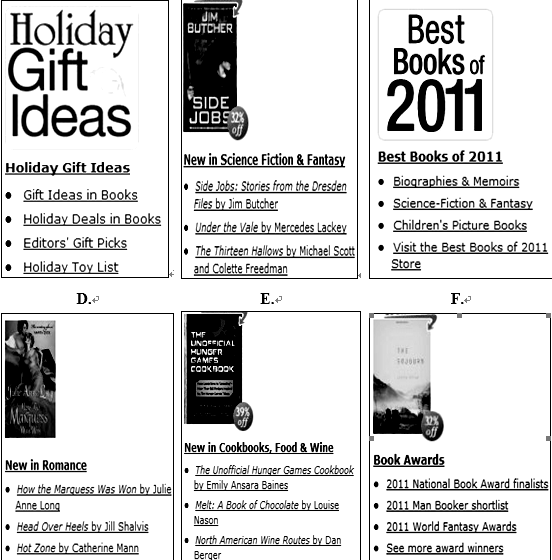第二節(jié) 信息匹配(共5小題;每小題2分,滿分10分)
閱讀下列應(yīng)用文及相關(guān)信息,并按照要求匹配信息。請(qǐng)將答案填涂在答題卡標(biāo)號(hào)為46~50的相應(yīng)位置上。
首先,請(qǐng)閱讀以下書籍分類介紹的網(wǎng)站欄目:
請(qǐng)閱讀以下人物信息,然后匹配人物與相關(guān)網(wǎng)站欄目:
46. Irene like reading love stories. From time to time she is moved by those romantic stories in the books, and she has a better understanding of the ups and downs in life through reading. Now she just wants to know what kind of new books of romance are available so that she can choose some of them for her reading during the next few weeks when she’s on holiday.
47. Philip Austin is a book-lover. He thinks that he can learn much more from books than any other resources. Of course, he always chooses to read wonderful books, and that’s why he’s now trying to find out books that have won different kinds of awards in the past year so that he can decide which to buy.
48. Eddy runs a bookstore in New York, and he is always trying his best to increase his book sale, so he usually recommends some really good books to his customers. To make his customers more satisfied, he intends to purchase some of the best books of 2011 that he can recommend to them. He wonders where he can find information for these books.
49. Jane Wilton quit her job as a secretary three years ago after she gave birth to her son Simon and became a housewife. She quite enjoys her life, cooking food for the family and taking care of Simon, and her husband, too. Now she wishes to know more about cooking, so she would like to know what kind of new cookbooks she can buy.
50. Mrs. Gibson works in a kindergarten. She loves those little kids and always gives them gifts during different holidays, which makes her most popular among the kids. Now she wishes to buy a book that could help her decide what to buy and where so that she wouldn’t have to worry about that any more.
III 寫作(共兩節(jié),滿分40分)
第一節(jié) 基礎(chǔ)寫作(共1小題,滿分15分)
以下是佛山剪紙藝術(shù)的相關(guān)信息:
歷史:
1) 傳統(tǒng)的民間藝術(shù),歷史悠久,起源于1000多年前;
2) 清朝時(shí)期開始盛行,是人們?nèi)粘I畹囊徊糠帧?br />種類:
1) 三種:用于裝飾、宗教和設(shè)計(jì);
2) 用于裝飾的剪紙使用最為廣泛。
現(xiàn)狀:
1) 送禮佳品,深受外國(guó)友人喜愛;
2) 有30多家經(jīng)營(yíng)剪紙的商店,產(chǎn)品遠(yuǎn)銷東南亞。
[寫作內(nèi)容]
請(qǐng)根據(jù)以上信息寫一篇英語短文,介紹佛山剪紙藝術(shù),供外國(guó)游客參考,內(nèi)容包括:
佛山剪紙藝術(shù)的歷史、種類及現(xiàn)狀。
[寫作要求]
1. 只能使用5個(gè)句子表達(dá)全部?jī)?nèi)容;
2. 作文中不能出現(xiàn)真實(shí)姓名和學(xué)校名稱。
[評(píng)分標(biāo)準(zhǔn)]
句子結(jié)構(gòu)準(zhǔn)確,信息內(nèi)容完整,篇章結(jié)構(gòu)連貫。
第二節(jié) 讀寫任務(wù) (共1小題,滿分25分)
閱讀下面的短文,然后按照要求寫一篇150詞左右的英語短文。
Forming good study habits is a great start on a path to success. Even small changes can make a big difference and, over time, will change not only your approach toward studying and organizing but your overall outlook on school and work.
Having effective study habits creates a more efficient academic environment. Planning your study schedule in advance and faithfully sticking to it saves time. Even giving consideration to small details makes a difference. Developing an efficient study plan can make your academic life go much more smoothly.
When you have good study habits, you tend to be less stressed. Students who are anxious on exam day are typically those who came unprepared. Students who organize their lives and stick to their study schedules are confident and relaxed at test-taking time.
Regardless of whether you are setting a good example for classmates or for friends, showing good study habits can have a positive effect on those around you. Your friends and classmates may turn to their own studies as you study. Your roommates may be inspired to organize their own rooms and study plans.
[寫作內(nèi)容]
你校的英文報(bào)組織了關(guān)于“養(yǎng)成良好學(xué)習(xí)習(xí)慣”的討論,上文是刊登在該報(bào)上的文章。你看完文章后,想就這一主題寫一篇英語短文并投稿,內(nèi)容包括:
1. 以約30詞概括上文的主要內(nèi)容;
2. 以約120詞就“養(yǎng)成良好學(xué)習(xí)習(xí)慣”進(jìn)行討論,并包括以下要點(diǎn):
(1)你有哪些好的學(xué)習(xí)習(xí)慣;
(2)好的學(xué)習(xí)習(xí)慣幫助你成功的經(jīng)歷;
(3)如何才能養(yǎng)成好的學(xué)習(xí)習(xí)慣。
[寫作要求]
1. 作文中可以使用親身經(jīng)歷或虛構(gòu)的故事,也可以參照閱讀材料的內(nèi)容,但不得直接引用原文中的句子。
2. 作文中不能出現(xiàn)真實(shí)姓名和學(xué)校名稱。
[評(píng)分標(biāo)準(zhǔn)]
概括準(zhǔn)確,語言規(guī)范,內(nèi)容合適,語篇連貫。
adj. 礦物的
n. 礦物,礦石











